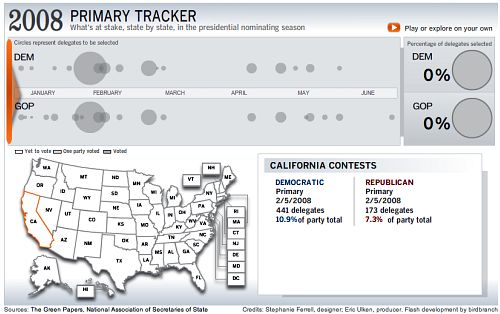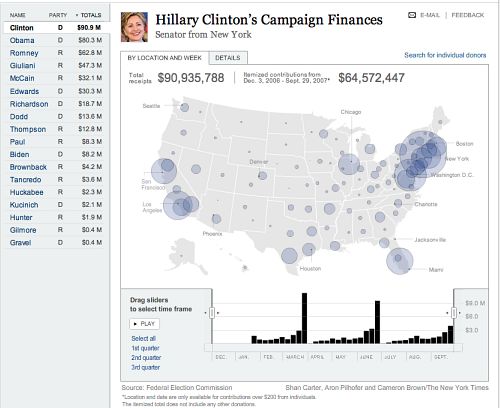The “Super Tuesday” brought record numbers of voters to polls and caucus sites across the United States this week… and substantial traffic to news websites. Political coverage provides online journalists a strong opportunity to shine — the set voting dates and established field of candidates allow newsrooms the advance notice and lead time that they need to build and test innovative new graphics and features, a couple of which we profiled on OJR late last year.
But when the Big Night arrives, readers are not satisfied with pre-planned features; they want vote returns, data analysis and a swift and accurate score of who’s won and lost. If those tasks were not demanding enough, the day strained the abilities of many newsrooms in the country’s midsection, as staffers reported on not just the primaries and caucuses, but a string of tornadoes from Alabama to Kentucky that ultimately killed more than 50 people.
OJR checked in via e-mail with Meredith Artley, editor of latimes.com; Mitch Gelman, senior vice president and executive producer of CNN.com; and Fiona Spruill, Editor, Web Newsroom, of The New York Times, to ask about what they found, and learned, from this year’s Super Tuesday.
How was traffic on Tuesday, compared with a normal Tuesday and with other top days at your site?
Spruill, NYT: It was huge. According to our internal traffic numbers, we saw more page views to the site in a 24-hour period than we ever have before.
Gelman, CNN: More than 97 million page views, double a normal weekday.
Artley, LAT: We saw good traffic numbers Tuesday. About 4.3 million page views according to our Omniture reports. That’s roughly a million more page views than an average day. Our record to beat is about 8 million page views in one day — we hit that during the October fires.
What was the single unique element on your website that you were most proud of?
Spruill, NYT: I’m afraid I can’t give you just one, so here are two:
1) Our election results graphics, which were updated on a minute-by-minute basis throughout the night. The depth of information we provided and the innovative display on the home page made for a great package.
2) The “Voices From the Polls” interactive feature, which included 124 audio interviews with voters across 24 states. We published it around midday on Tuesday and added to it throughout the day.
Gelman, CNN: The rapid results and updating delegate counts allowed the audience to follow the evolution of the events in real time, along with the live video coverage with four simultaneous live streams exclusively online that resulted in another nearly 600,000 views through the day.
Artley, LAT: It’s a three-way tie! The Top of the Ticket blog, which is quickly climbing the Technorati charts, is a shining example of how news organizations can pair smart reporters with a platform that lets them be prolific and interactive. Andy Malcolm, Don Frederick and Scott Martelle are blogging the heck out of the campaign season — breaking a lot of news, linking out and getting linked to. And they tell me they are having a great time.
We are also proud of the live California results map. It was done in Flash, put together by Sean Connelley, our interactive graphics producer with help from Stephanie Ferrell, Ben Welsh and Eric Ulken. This map and Top of the Ticket were the two most viewed elements of our campaign coverage.
Lastly, we are proud of the “vote cloud” as a way of clearly presenting how the candidates are faring state-by-state and nationwide. We set out to not be too “charty” and to give readers something they can quickly understand at a glance, while providing easy access to deeper information. The cloud will continue to be available from the Campaign ’08 page.
What was the lesson that you learned from your Super Tuesday coverage that you did not know before?
Spruill, NYT: The “Voices From the Polls” feature is one of the most ambitious Web-only projects we have ever undertaken. It is great to know that we can publish something so comprehensive (124 interviews in 24 states) with such a tight turnaround. I was also pleased with the way we conceived of a project for the Web that was a perfect complement to our coverage in print but stood on its own online.
Gelman, CNN: That America has fully embraced the two-screen election results experience. CNN won the ratings on TV and CNN.com had one its best nights ever, showing that in order to fully follow an election, you need to turn to CNN online and on air!
Artley, LAT: As for new lessons, I found the variety of presentations among news sites fascinating. Lots of discussion about that in the LAT newsroom. CNN.com went with straightforward and simple approach — one photo, one headline, and usually bullet points with updates. Their maps and charts were farther down the page, unlike NYTimes.com who went with a big chart at the top of their homepage. Washingtonpost.com divided the page down the middle between Dem and GOP stories, with interactive maps. I suppose this is all more of an observation than a lesson, but it seems that after years of news sites looking largely the same for election coverage, we’re starting to see different philosophies and a new wave of creativity in terms of presentation. That’s gotta be a very good thing for our readers.










